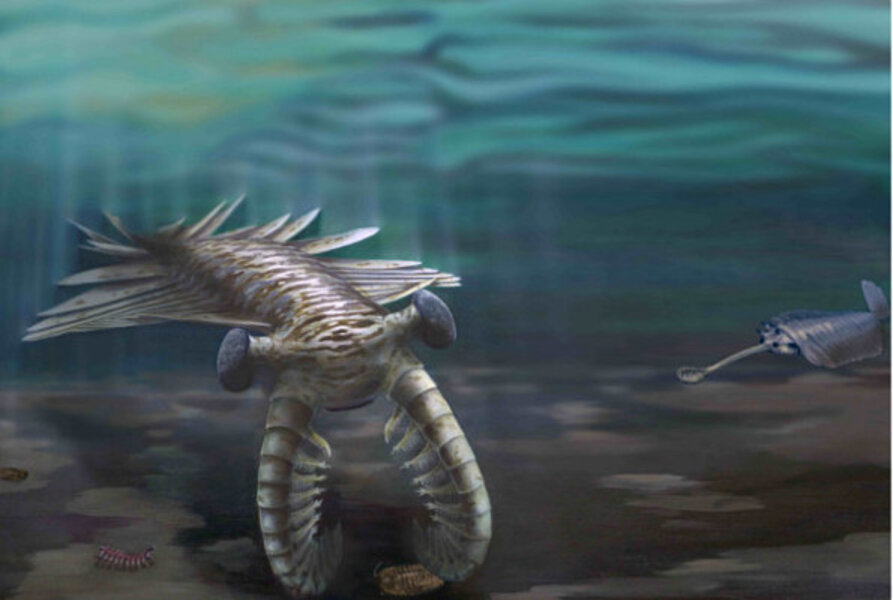Evolutionary biologists resolve 'Darwin's dilemma'
Loading...
When creationists argue against evolution, they'll often mention "Darwin's Dilemma," the head-scratching paleontological reality that the fossil record appears to have begun all at once, about half a billion years ago. The "Cambrian explosion," as it's called, refers to the rapid appearance of most modern animal groups between 540 and 520 million years ago, during the Cambrian Era.
When writing his "Origin of Species," Charles Darwin admitted that he couldn't explain why the fossil record began so abruptly. "The several difficulties here discussed, namely ... the sudden manner in which several whole groups of species first appear in our European formations;—the almost entire absence, as at present known, of formations rich in fossils beneath the Cambrian strata,—are all undoubtedly of the most serious nature." While acknowledging that these constituted serious holes in his theory, he trusted that later scientists would resolve them.
One group of scientists now say they've solved a big chunk of the puzzle: they've made the first-ever estimates of the rates of evolution during the Cambrian explosion – and it wasn't as fast as it sounds. While the word "explosion" implies a split-second transformation, evolution in the Cambrian was only 4 to 5 times faster than in later years, they say. That's like the difference between flying in a puddle-jumper versus a commercial jet. It's faster, to be sure, but it's not the difference between walking and the speed of light.
"Quite rapid," says lead author Michael Lee, "but perfectly consistent with Darwin's theory of evolution."
In the 150 years since Darwin published his revolutionary theory, evolutionary biologists have tackled several of the different mysteries of the "Cambrian explosion."
The problem of the abrupt beginning to the fossil record was resolved in the 1950s, with the discovery of pre-Cambrian life forms. Why hadn't they left fossils like their Cambrian cousins? Simple: These squishy creatures, similar to slugs, worms, and jellyfish, didn't have bones or shells that could fossilize. With that discovery, scientists had proof that the Cambrian explosion didn't mark the dawn of life – just the beginning of life with hard parts.
But that's its own mystery, and has remained a lingering challenge to evolution: How could so many unrelated creatures all evolve with shells, exoskeletons, carapaces, and other hard parts, all at once?
"The abrupt appearance of dozens of animal groups during this time is arguably the most important evolutionary event after the origin of life," says Dr. Lee, who teaches at Australia's University of Adelaide and works at the South Australian Museum, in a press release.
"These seemingly impossibly fast rates of evolution implied by this Cambrian explosion have long been exploited by opponents of evolution. Darwin himself famously considered that this was at odds with the normal evolutionary processes. However, because of the notorious imperfection of the ancient fossil record, no one has been able to accurately measure rates of evolution during this critical interval, often called evolution's Big Bang."
Until now.
With colleagues from Australia and London's Natural History Museum, Lee measured anatomic and genetic differences between living animals, and used fossils and mathematical models to establish the rate at which those differences accumulated. Their models showed that quick, but not lightning fast, evolution could explain the arrival of the many kinds of animals in the Cambrian explosion.
In the Cambrian, animals evolved visible differences about 4 times faster than in later years, and molecular evolution was even faster – about 5.5 times the rate of subsequent evolution, say the researchers.
They focused on arthropods – bees, lobsters, spiders, insects and all their cousins – which were, and still are, the most diverse animal phylum.
Many arthropod features, "like a hard exoskeleton, jointed legs, and compound (multi-faceted) eyes" all evolved during the Cambrian, says co-author Dr. Greg Edgecombe of the Natural History Museum. "We even find the first appearance in the fossil record of the antenna that insects, millipedes, and lobsters all have, and the earliest biting jaws."
In geological terms, the Cambrian, and all modern life that followed, is a very recent phenomenon. To put it all into perspective, imagine that all of Earth history is laid out on a football field. On your team's goal line is Earth's formation, 4.6 billion years ago. Start walking from there and see the moon form, stroll past the creation of the continents on the 5 yard line, watch plate tectonics shove the continents around.
By the 50 yard line, there's still no life other than primitive bacteria. You're the other team's 30 yard line before the bacteria develop nuclei. You have to get to the 15 yard line – 85 yards from where you started, almost the whole length of the field – before you spot the first worm.
A few steps later, squishy pre-Cambrian creatures become common. Near the 11 yard line you'll see the Cambrian explosion. Within an easy step – about a foot and a half – we've gone from gelatinous life to millions of species with hard parts, including fish, clams, and creatures called trilobites that look like roly poly bugs.
At the 10 yard line, you see the first plants.
Dinosaurs start to show up at the 5 yard line, and make it to within 5 feet of the goal before going extinct.
The earliest human-ish creatures appear less than a foot from the goal line, and Homo sapiens doesn't show up till within a quarter-inch of the goal.
All of human history is there in the last blades of grass before the end of the field.
"There is grandeur in this view of life," wrote Darwin, that "from so simple a beginning, endless forms most beautiful and most wonderful have been, and are being evolved.”








